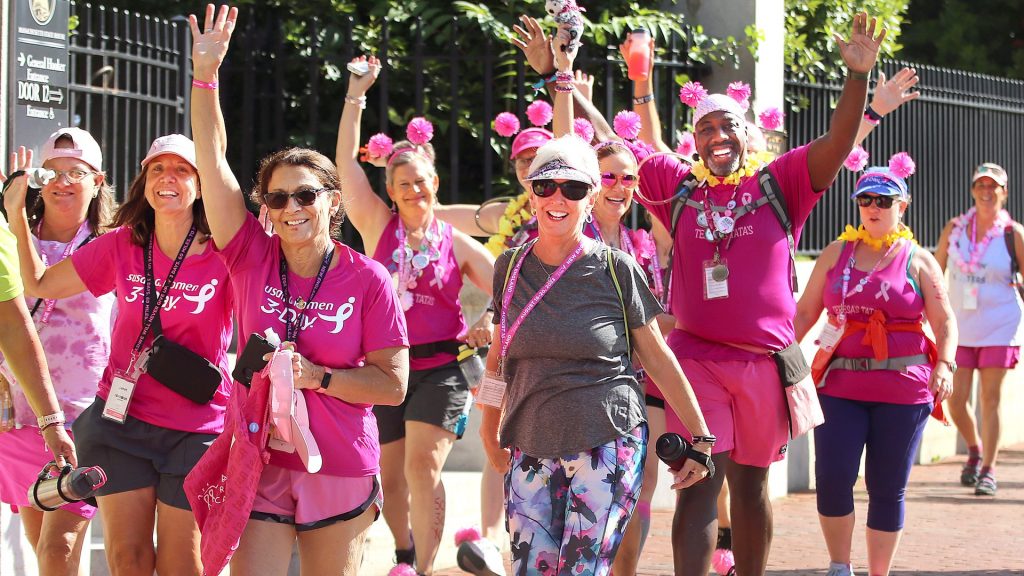What to consider before donating to a breast cancer cause or charity

Each October, a sea of pink floods streets, social media and storefronts as millions rally behind a global movement that began as a week-long campaign to promote breast cancer awareness. Now four decades strong, the initiative has evolved into a powerful global force for advocacy, research and early detection.
It’s been 40 years since that first modest week in 1985 — and that marks a significant milestone, according to Arif Kamal, chief patient officer at American Cancer Society.
“Breast cancer mortality is down more than 40%, and 40 is when women should start having a conversation with their doctor about getting a mammogram,” Kamal said in a prepared statement.
Driven by ribbons, runs and relentless hope, Breast Cancer Awareness Month has helped save more than half a million lives and made major advancements in technology, vaccines and immunotherapy, according to the American Cancer Society.
How many breast cancer charities are there in the US?
“In 1986, breast cancer wasn’t talked about openly, and that silence costs lives,” said Dorothy Gibbons, the co-founder and CEO of The Rose, a Houston-based organization that aims to save lives through quality breast health services, advocacy and access to care for all. “There were no public education campaigns, very little media attention, and virtually no resources for uninsured women.”
The “awareness” part of Breast Cancer Awareness Month required a lot of work in the early days.
“We went from a world where the word ‘breast’ couldn’t be spoken on air to one where survivors share their stories publicly and proudly,” Gibbons said. “Saying ‘breast cancer’ out loud was uncomfortable for many.”
That’s no longer the case. These days, even NFL football players — the prototype for American masculinity — wear pink shoes with pride.
With more than 1,200 nonprofit organizations in the U.S. with breast cancer in their name vying for attention, supporters face a growing dilemma: how to ensure their time, money and energy make the most meaningful impact. The challenge isn’t whether to support the cause — it’s how.
”Probably the most important thing someone can do is just find out more before you give,” said Bennet Weiner, the president and CEO of BBB Wise Giving Alliance, a nonprofit that provides donors with information to help inform their giving decisions.
Weiner recommends donors take time to thoroughly research a charity to ensure they’re giving with confidence — prioritizing transparency around its mission, spending and impact — and resisting pressure to make impulsive or emotionally driven donations.
What is ‘pinkwashing’?
Pink-ribbon marketing culture is so rampant this time of year that Breast Cancer Action coined the term “pinkwashing” in 2002 to describe companies or organizations promoting a pink-ribbon product while also making or selling products containing chemicals linked to the disease.
“Don’t assume that a specific charity is being helped if you see a ribbon; see if the product packaging tells you more about what the connection is,” Weiner said.
That’s why BBB has a cause-related marketing disclosures standard, Weiner said, which requires organizations to be transparent about how much of a consumer’s purchase will go toward the intended cause.
He also stressed the importance of being mindful of “lookalikes,” in which two charities may have similar names.
“The similarity may not necessarily be an indication of any deception; it’s just that organizations are raising money for the same issues,” Weiner told Straight Arrow News. “Unfortunately, there are occasions where there are lookalikes in terms of someone who is trying to fool the public into thinking they’re someone they’re not.”
Every two years, BBB Wise Giving Alliance voluntarily evaluates charities based on 20 accountability standards from governance and oversight to effectiveness and finances. About 70% of organizations meet their standards, earning an accreditation, Weiner said.
Money is an important part of that process, but it’s not everything.
“Finances are just a piece of the accountability pie. It doesn’t really provide a full picture of what the charity is about, and they should consider a lot more than just the expenditures of the organization,” Weiner told SAN.
He advised that would-be donors also consider the makeup of the board, the organization’s mission and program focus.
How do you know if a charity is using donations properly?
“The vast majority of charities are operating ethically,” Weiner said. “The risk is that you may be unfortunately giving to one that is not doing a good job. Maybe they have a vague appeal that really doesn’t tell you what the charity is really doing. Maybe they have a situation where they’re not spending as much on their program activities as you would anticipate. Maybe they’re not carrying out the type of activities that you want to support.”
For decades, Susan G. Komen has been a dominant force in breast cancer advocacy, channeling more than $1 billion into research since its founding in 1982, according to its website.
But in 2012, it succumbed to scrutiny after cutting funding to Planned Parenthood. The decision was reversed after facing backlash, but it prompted inquiries into how the organization operated and spent its money.
Weiner said that how an organization appeals to people about what they do is important.
“If research is not the largest program, then their appeal should be focusing on identifying the activities that they are most engaged in,” he said. “The key is not how much anyone spends on any particular area, but is there any impression that is made by appeals that indicates that they’re spending more on a certain area than they actually are? And that’s where I think a concern can emerge.”
In 2023, Susan G. Komen spent $27.2 million on fundraising, according to its IRS filings. At the same time, the organization reported spending $24.2 million on research. That means for every $1 spent on research, $1.13 was spent on fundraising.
“It takes money to raise money,” Weiner told SAN. And, he added, it should only be a red flag if an organization emphasizes one activity over others.
While research has always been a key part of the organization’s mission — its signature event was long called “Race For The Cure” — caring for patients is also a top priority, said Victoria Wolodzko Smart, senior vice president of mission at Susan G. Komen.
Should donations go to research? Patient care? Who gets to decide?
In 2023, the organization funneled 74% of its expenses toward research, to the tune of $79 million.
The nonprofit launched the Komen Patient Care Center in 2021 to provide free breast health and breast cancer information, services, and resources to patients, caregivers and family members. The center has helped more than 143,967 people, according to Komen’s latest annual report.

And treatment is essential. The American Cancer Society estimated that 42,250 women were expected to die from breast cancer in 2024. That’s a lot of mothers, sisters, daughters and nieces. But it’s also a much smaller number than at the beginning of the breast cancer awareness movement: The breast cancer death rate has declined by 44% since 1989 because of advances in both early detection — often funded by research — and treatment.
“To date, we’ve invested more than $3.5 billion across research, advocacy, community programs and patient care, contributing to 29 of the 30 breast cancer drugs approved by the FDA over the past 30 years,” Wolodzko Smart told SAN in an email. “Susan G. Komen is the largest nonprofit funder of breast cancer research and the second-largest overall, behind only the U.S. government.”
But ultimately, who a donor decides to support — be it a large, national brand or a smaller local organization — is based on preference.
“I don’t think there is a better one way or another because everyone has their own sense of what they feel is most important,” Weiner said.
The post What to consider before donating to a breast cancer cause or charity appeared first on Straight Arrow News.





